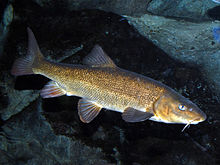Barbusis agenusofray-finned fishin thefamilyCyprinidae.Thetype speciesofBarbusis thecommon barbel,first described asCyprinus barbusand now namedBarbus barbus.Barbusis the namesake genus of thesubfamilyBarbinae, but given their relationships, thattaxonis better included in theCyprininaeat least for the largest part (including the type species ofBarbus).
| Barbus | |
|---|---|

| |
| Barbus barbus | |

| |
| Barbus plebejus | |
| Scientific classification | |
| Domain: | Eukaryota |
| Kingdom: | Animalia |
| Phylum: | Chordata |
| Class: | Actinopterygii |
| Order: | Cypriniformes |
| Family: | Cyprinidae |
| Subfamily: | Barbinae |
| Genus: | Barbus Daudin, 1805[1][2] |
| Type species | |
| Cyprinus barbus | |
Description and uses
editTheir common names –barbsandbarbels– refer to the fact that most members of the genera have a pair ofbarbelson their mouths, which they can use to search for food at the bottom of the water.
Barbels are oftenfishedfor food; in some locations they are of commercial significance. Theroeof barbels is poisonous, however. The largeBarbusbarbs are also often eaten in their native range.
The smaller barbs are in some cases traded asaquariumfish. Some are quite significant, but as a whole, the genus is not yet as well represented in aquaria as theSoutheast AsianPuntius.[3]
Systematics and taxonomy
editBarbushas a long history as a "wastebasket taxon".Historically, most fish commonly known as"barbs"were usually placed here by default. More recently, many" barbs "have been reclassified into genera such asArabibarbus,Barbichthys,Barbodes,Barboides,Barbonymus,Barbopsis,Caecobarbus,Capoeta,Carasobarbus,Clypeobarbus,Enteromius,Hypselobarbus,Hypsibarbus,Labeobarbus,Leptobarbus,Luciobarbus,Mesopotamichthys,Poropuntius,Probarbus,Pseudobarbus,PuntioplitesandPuntius.[4]
Thus,Barbusis for the time being restricted to typical barbels, and only contains fishes fromAfricaandEurope,as well as adjacentAsia.However, the genus even in the reduced version is probablyparaphyletic,and many African species (particularly the small ones) do not seem to belong here, either. Eventually,Barbusis likely to be restricted to the group aroundB. barbus– the large European toPonto-Caspianspecies commonly known as "barbels".Luciobarbusand particularlyMessinobarbusare highly similar and might better be included inBarbusagain. They all seem to be close relatives – perhaps the closest living relatives – ofAulopyge huegelii.CarasobarbusandLabeobarbusare probably closely related to this group, too, and some largehexaploidbarbs (e.g.L. reinii) may well belong inLabeobarbus.[citation needed]
The small barbs from Africa, by contrast, are quite distinct. They might even warrant establishment of a newsubfamily– in particular if theLabeoninaeare not included in the Cyprininae –, as they seem to be as distinct from barbels andtypical carps,as these are from thegarras(which are part of the disputed Labeoninae), rendering the old "Barbinae"paraphyletic.Within the small African barbs, several lineages can be recognized. These are mostlydiploid;atetraploidgroup largely restricted to southern Africa is very close toPseudobarbusand might even be included therein. In particular, the group called "redfins" may well bemonophyleticand belong inPseudobarbusentirely, instead of being split betweenPseudobarbusandBarbus.[citation needed]
Species
editThere are currently 36 recognized species of this genus:[5]
- Barbus balcanicusKotlík,Tsigenopoulos,Ráb&Berrebi,2002(Danube barbel)
- Barbus barbus(Linnaeus,1758)(Common barbel)
- Barbus bergiChichkoff,1935(Bulgarian barbel)
- Barbus biharicusAntal,László& Kotlík, 2016(Biharian barbel)[6]
- Barbus borysthenicusDybowski,1862
- Barbus caninusBonaparte,1839(brook barbel)
- Barbus carottae(Bianco,1998)(Yliki barbel)
- Barbus carpathicusKotlík, Tsigenopoulos, Ráb & Berrebi, 2002(Carpathian barbel)
- Barbus ciscaucasicusKessler,1877(Terek barbel)
- Barbus cyclolepisHeckel,1837
- Barbus cyriDe Filippi,1865(Kura barbel)
- Barbus euboicusStephanidis,1950(Evia barbel)
- Barbus fuciniCosta, 1853
- Barbus haasiMertens,1925(Catalonian barbel)
- Barbus karunensisKhaefi, Esmaeili, Geiger & Eagderi, 2017(Karun barbel)
- Barbus kubanicusL. S. Berg,1913(Kuban barbel)
- Barbus lacertaHeckel, 1843(lizard barbel)
- Barbus lortetiSauvage,1882(Lortet's barbel)
- Barbus macedonicusS. L. Karaman, 1928
- Barbus meridionalisA. Risso,1827(Mediterranean barbel)
- Barbus miliarisDe Filippi, 1863
- Barbus niluferensisTuran,Kottelat&Ekmekçi,2009(Simav barbel)
- Barbus oligolepisBattalgil,1941(Marmara barbel)
- Barbus peloponnesiusValenciennes,1842
- Barbus pergamonensisM. S. Karaman, 1971(Anatolian barbel)
- Barbus petenyiHeckel, 1852(Romanian barbel)
- Barbus plebejusBonaparte, 1839(Italian barbel)
- Barbus prespensisS. L. Karaman,1924
- Barbus rebeliKoller,1926(Western Balkan barbel)
- Barbus samniticusLorenzoni, Carosi, Quadroni, De Santis, Vanetti, Delmastro & Zaccara, 2021
- Barbus sperchiensisStephanidis, 1950(Sperchios barbel)
- Barbus strumicaeS. L. Karaman, 1955(Strumica barbel)
- Barbus tauricusKessler, 1877(Crimean barbel)
- Barbus thessalusStephanidis, 1971(Thessalian barbel)
- Barbus tyberinusBonaparte, 1839(Horse barbel)
- Barbus waleckiiRolik,1970(Vistula barbel)
Fossil species
editA fossil species (Barbus megacephalusGünther, 1876) is known from thePaleogeneSipang FaunaofIndonesia.,[7]but it probably should be placed in another genus.
See also
editReferences
edit- ^Skelton, P. H., Swartz, E. R., & Vreven, E. J. (2018). The identity ofBarbus capensisSmith, 1841 and the generic status of southern African tetraploid cyprinids (Teleostei, Cyprinidae). European Journal of Taxonomy, (410).https://doi.org/10.5852/ejt.2018.410
- ^Englmaier GK, Tesfaye G, Bogutskaya NG (2020) A new species ofEnteromius(Actinopterygii, Cyprinidae, Smiliogastrinae) from the Awash River, Ethiopia, and the re-establishment ofE. akakianus.ZooKeys 902: 107–150.https://doi.org/10.3897/zookeys.902.39606
- ^Lambert, D.J. (1997):Freshwater Aquarium Fish.Chartwell Books, Edison, New Jersey, USA.ISBN0-7858-0867-1
- ^Banister, K.E. (1973): A revision of the largeBarbus(Pisces, Cyprinidae) of East and Central Africa. Studies on African Cyprinidae. Part II.Bulletin of the British Museum, 26 (1): 3–148.
- ^Froese, Rainer;Pauly, Daniel (eds.)."Species in genusBarbus".FishBase.July 2024 version.
- ^Antal, L., László, B., Kotlík, P., Mozsár, A., Czeglédi, I., Oldal, M., Kemenesi, G., Jakab, F. & Nagy, S.A. (2015): Phylogenetic evidence for a new species ofBarbusin the Danube River basin.Molecular Phylogenetics and Evolution, 96: 187–194.
- ^Woodward, A.S. (1901).Catalogue of the Fossil Fishes in the British Museum (Natural History).order of the Trustees. p.302.
barbus megacephalus.